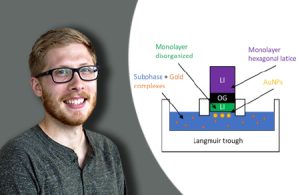IMPMC – Barre 22-23, 4e étage, salle 401.
Guillaume Diot, doctorant dans l’équipe Physico-chimie et dynamique des surfaces
 Étude de l’interface liquide ionique et oxyde de graphène par la procédure des films de Langmuir : influence de l’ajout d’or en sous-phase et formation de nanoparticules d’or
Étude de l’interface liquide ionique et oxyde de graphène par la procédure des films de Langmuir : influence de l’ajout d’or en sous-phase et formation de nanoparticules d’or
Résumé
Les supercondensateurs utilisent le liquide ionique (LI) comme électrolyte et le graphène ou l’oxyde de graphène (OG) comme électrode. Ce sont des dispositifs de stockage d’énergie prometteurs car ils possèdent une grande densité de puissance. Cependant, ils souffrent d’une faible densité de stockage d’énergie à cause de l’accès restreint de l’électrolyte à l’électrode. Pour améliorer cette caractéristique, il est nécessaire d’étudier l’interface entre l’électrolyte et l’électrode. Une méthode permettant de réaliser cette interface est la procédure des films de Langmuir. Le premier objectif est d’utiliser cette procédure afin d’élaborer un film mixte de LI et d’OG sur une sous-phase d’eau pure. De plus, l’ajout de nanoparticules métallique entre les feuillets de graphène semble améliorer les propriétés de conductivité des charges. Ainsi, le second objectif est d’étudier ces films mixtes de LI et d’OG en présence de complexe d’or [AuCl4]– introduit en sous-phase et de tenter de former des nanoparticules d’or (AuNPs) par radiolyse de surface. L’ensemble de ces films a été caractérisé par différentes méthodes expérimentales comme des isothermes, de la diffraction et de la fluorescence utilisant des rayons X en incidence rasante ainsi que de la microscopie à force atomique. Nous avons tout d’abord montré qu’il était possible de réaliser ces interfaces LI/OG à l’interface avec une sous-phase d’eau pure pour différentes concentrations en oxyde de graphène. Il semble que l’organisation de la couche de LI autour des feuillets dépende des autres interfaces. Lorsque le liquide ionique est en contact avec l’air, il peut être organisé selon le réseau du graphène. Lorsque le LI est en contact avec une sous-phase d’eau pure, le LI reste désorganisé au contact des feuillets. Nous avons ensuite étudié ce film mixte pour une concentration en OG et LI fixe et pour différentes concentrations en complexe d’or, introduit en sous-phase. Nous avons mis en évidence que l’organisation du film de LI par rapport à l’OG dépendait de la quantité de complexe d’or introduit en sous-phase suggérant la présence de ces complexes dans le film de LI. Enfin, l’irradiation des couches a été réalisée et a montré que la formation des AuNPs était fortement influencée par la présence des complexes d’or dans les couches de Langmuir.
Study of the ionic liquid and graphene oxide interface using the Langmuir films procedure: influence of the addition of gold in the subphase and formation of gold nanoparticles
Abstract
Supercapacitors based on ionic liquid (IL) as an electrolyte and graphene or graphene oxide (GO) as an electrode are promising energy storage units due to their high power density. However, they suffer from low energy storage density due to the restricted access of the electrolyte to the electrode. To improve this characteristic, it is necessary to study the interface between the electrolyte and the electrode. One method for achieving this interface is the Langmuir film procedure. The first objective is to use this procedure to develop a mixed film of IL and GO on a subphase of pure water to form the GO/IL interface. Moreover, the addition of mettalic nanoparticles between the graphene sheets seems to improve the charge conductivity properties. Thus, the second objective is to study these mixed films of IL and GO in the presence of gold complex [AuCl4]– introduced in the subphase and attempt to form gold nanoparticles (AuNPs) through surface radiolysis. All these films were characterized using various experimental methods such as isotherms, diffraction, and fluorescence utilizing X-rays at grazing incidence, as well as atomic force microscopy. We initially demonstrated the feasibility of creating these IL/OG interfaces at the interface with a pure water subphase for different concentrations of graphene oxide. The organization of the IL layer around the sheets appears to depend on other interfaces. When the ionic liquid is in contact with air, it can organize itself according to the graphene network. However, when the IL is in contact with a pure water subphase, it remains disorganized at the contact with the sheets. Subsequently, we studied this mixed film for a concentration of GO and IL fixed and various concentrations of gold complex introduced into the subphase. We highlighted that the organization of the IL film in relation to GO depends on the quantity of gold complex introduced into the subphase, suggesting the presence of these complexes in the IL film. Finally, irradiation of the layers was carried out and showed that the formation of AuNPs was strongly influenced by the presence of gold complexes in the Langmuir layers.
Jury
- Sylvie COHEN-ADDAD (INSP, Paris), Examinatrice
- Michel GOLDMANN (INSP, Paris), Directeur de thèse
- François MULLER (ECE, Paris), Co-encadrant de thèse
- Hynd REMITA (LCP, Paris-Saclay), Examinatrice
- Samy REMITA (CNAM, Paris-Saclay), Rapporteur
- Frédéric RESTAGNO (LPS, Paris-Saclay), Rapporteur

